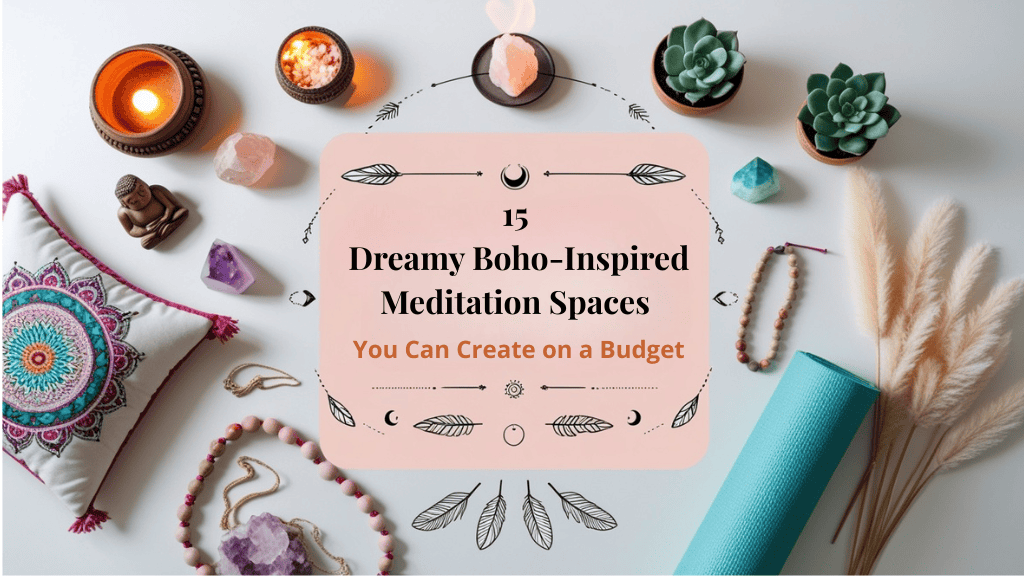
Table of Contents
Are you yearning for a peaceful sanctuary within your home but worried about the cost? Creating a meditation space doesn’t have to drain your bank account! With some creativity and thrifty finds, you can transform even the smallest corner into a bohemian oasis that nurtures your soul and supports your mindfulness practice.
The bohemian aesthetic, with its embrace of natural materials, eclectic textures, and spiritual elements, perfectly complements meditation practice by creating an environment that feels both grounding and uplifting.
I’ve spent years designing and decorating my own meditation spaces in various apartments and homes, always on a budget that would make most interior designers gasp! What I’ve discovered is that the most tranquil spaces aren’t always about expensive purchases but thoughtful curation of elements that speak to your spirit.
Whether you’re converting a tiny nook in your studio apartment or transforming your patio into an outdoor zen retreat, these budget-friendly boho meditation space ideas will help you create a sanctuary that feels like a warm hug for your soul!
What You Might Need
- Floor cushions or pillows
- Natural fiber rugs (jute, cotton, or wool)
- Plants (real or artificial)
- String lights or candles
- Fabric for wall hangings or room dividers
- Baskets for storage
- Incense or essential oils
- Meditation tools (singing bowls, mala beads)
- Thrifted items with bohemian flair
1. What Makes a Space “Boho-Inspired” for Meditation?

Bohemian style creates the perfect meditation atmosphere with natural materials, layered textures, and personal touches. The earth tones and handcrafted elements ground your energy during practice, while the bohemian aesthetic wraps you in comfort while maintaining peaceful vibes.
My meditation deepens when surrounded by elements that speak to my soul rather than following strict design rules. The beauty of boho is its embrace of imperfection – your special crystal, handmade pillow, or beloved plant all contribute to a space that feels authentically yours!
Benefits of Bohemian Elements
Bohemian spaces incorporate natural materials like wood, rattan, and cotton that ground your energy and create a connection to the earth element.
Enhancing Sensory Experience
The layered textures, soft fabrics, and atmospheric lighting of boho spaces stimulate the senses in a gentle way that enhances mindfulness rather than causing distraction.
Pairing Spirituality with Style
Bohemian design naturally incorporates spiritual elements like crystals, Buddha figures, and symbolic art that can deepen your meditation practice while also serving as beautiful decor.
How to Create This Look
- Start with natural materials as your base – jute rugs, wooden accents, and cotton textiles
- Layer different textures and patterns that bring you joy
- Incorporate meaningful spiritual elements that support your practice
- Add plants to connect with nature and improve air quality
- Choose warm, earthy colors complemented by rich jewel tones
2. Finding the Perfect Spot: Selecting Your Meditation Area
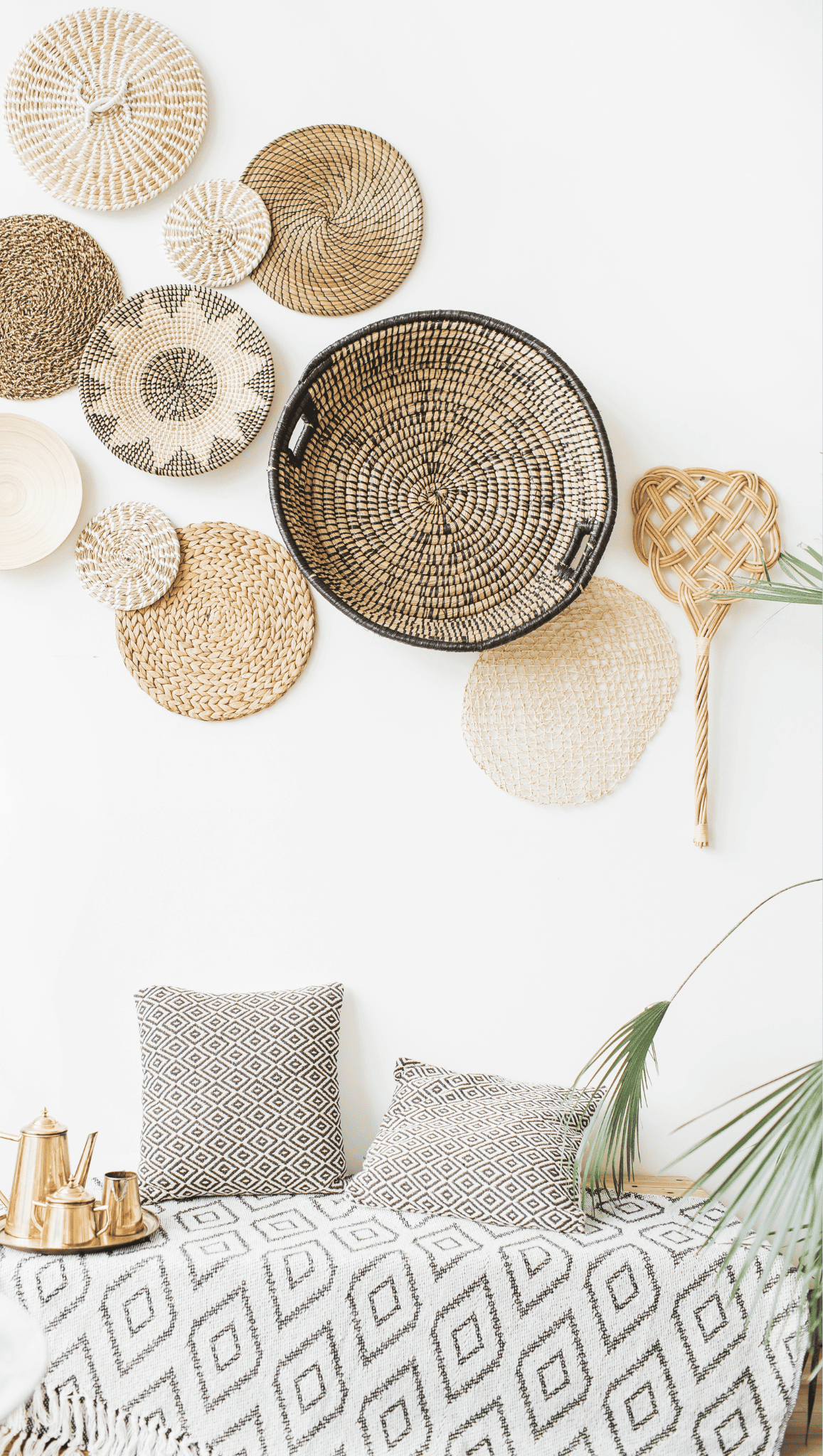
Finding my perfect meditation spot started with recognizing hidden potential in my home! That awkward corner by the window had the best natural light and quietest atmosphere. Look for underutilized spaces offering privacy and some natural light – even a tiny 3×3 foot area can become a transformative zen nook.
Different spots have different energies – windows feel expansive while corners feel grounding. Morning meditators might love eastern exposure for sunrise light, while evening meditators may prefer the golden hour glow. Don’t overlook surprising spaces like hallway ends or transformed closets!
Benefits of Natural Light
Meditation spaces with access to natural light help regulate your circadian rhythm while providing vitamin D and a natural mood boost during your practice.
Enhancing Small Spaces
Even the tiniest areas can become dedicated meditation zones when you clearly define the boundaries using rugs, screens, or changes in decor style.
Pairing Function with Tranquility
The best meditation spots balance practical considerations like noise levels and traffic flow with elements that promote peace and focus.
Steps to Find Your Perfect Spot
- Observe your home at different times of day to identify quieter areas
- Look for underutilized spaces – window nooks, corners, wall spaces between furniture
- Consider natural light sources and how they change throughout the day
- Test different spots by sitting quietly for five minutes – notice how each space feels
- Think about privacy needs and how to create boundaries in shared living situations
3. Essential Elements for Your Budget-Friendly Meditation Nook

Some meditation elements are worth investing in while others can be creatively sourced on a budget! The foundation is comfortable seating – whether floor cushions, a bench, or a repurposed chair. I started with a simple couch pillow before finding a proper meditation cushion on sale! Good seating keeps your body still while your mind quiets.
Boho style celebrates handcrafted and repurposed items – perfect for budget-conscious meditators! I’ve found treasures at thrift stores, yard sales, and in nature. Branches became wall hangings, scarves transformed into cushion covers. Plants add life without major expense. Remember: authenticity trumps perfection – your space should feel collected rather than bought as a matching set!
Benefits of Floor Cushions
Dedicated meditation cushions or repurposed pillows provide comfort during longer sessions while also creating a visual cue that this space is reserved for your practice.
Enhancing Atmosphere Through Textiles
Affordable textiles like scarves, tapestries, and even repurposed fabric can be used as wall hangings, cushion covers, or space dividers that add color and texture.
Pairing Functionality with Beauty
The most successful meditation spaces incorporate elements that are both practical and aesthetically pleasing, like beautiful baskets that also store your meditation tools. I’ve found that thrift stores can be a great place to find a variety of baskets!
How to Gather Essential Elements
- Start with comfortable seating – a cushion, pillow, or low bench
- Define your space with a special rug or mat (even a folded blanket works)
- Add natural elements like plants, stones, or branches
- Include a small surface for meditation tools or meaningful objects
- Incorporate soft lighting with candles, string lights, or a salt lamp
4. 7 DIY Projects to Personalize Your Boho Meditation Space
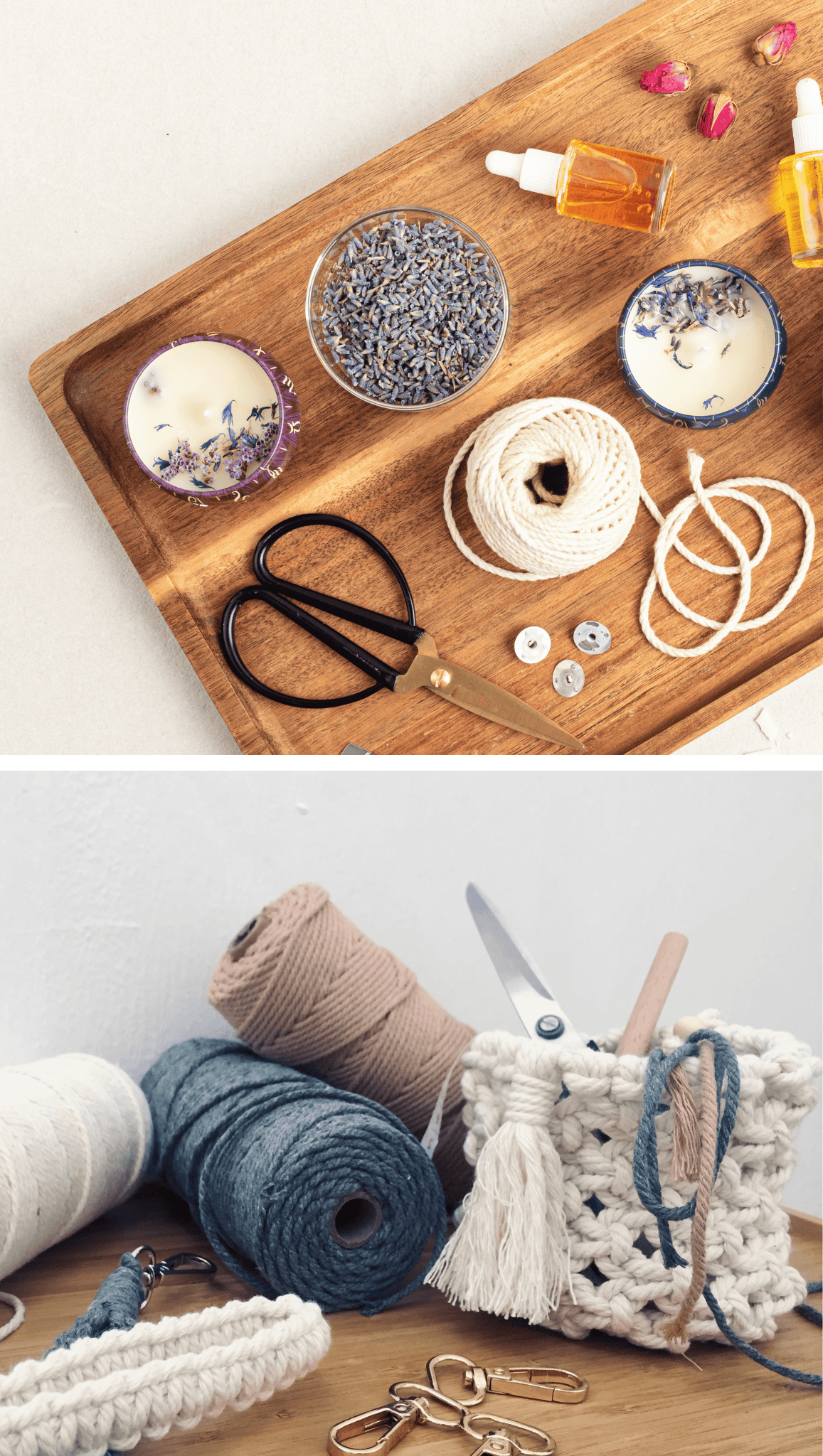
My most treasured meditation elements are ones I’ve created myself! There’s something magical about surrounding yourself with handmade items – they carry your energy and intention. Simple, heartfelt creations often bring the most joy while keeping costs minimal. Even with basic crafting skills, you can create beautiful elements that give your space authentic bohemian flair.
Bohemian style celebrates imperfect, handcrafted elements. My first meditation altar was a simple wooden box I sanded and stained, transforming trash into treasure! Experiment with natural dyes, simple weaving, or repurposing items you already own. My favorite tools are ones I’ve created – like intention stones painted with meaningful symbols and prayer beads strung from my collection.
Benefits of Handmade Elements
Creating elements for your meditation space infuses them with personal meaning and intention, deepening your connection to your practice environment.
Enhancing Energy Through Creation
The act of making something with your hands can itself be meditative, meaning your DIY projects double as mindfulness practice before they even enter your space.
Pairing Simplicity with Meaning
The most powerful handmade elements often use the simplest techniques but carry the deepest personal significance.
How to Create Personalized Elements
- Transform plain cushions with fabric paint in mandala or geometric patterns
- Create a simple macramé wall hanging using cotton rope and driftwood
- Make no-sew floor pillows by tying fabric around pillow stuffing
- Paint stones with intentions, mantras, or meaningful symbols
- Craft a nature mobile using found objects like feathers and small branches
- Create your own meditation cards with inspirational phrases or images
- Design a simple altar from a repurposed wooden box or crate
- Make homemade candles
5. Textile Magic: Using Fabrics to Transform Your Space

The moment you draped a vintage fabric across your ceiling, your meditation corner transforms from an afterthought to a sacred space! Textiles add immediate warmth, color, and defined boundaries without permanent changes – perfect for renters. Layered patterns and textures create visual interest while absorbing sound for a quieter practice environment.
Finding beautiful textiles on a budget requires creativity but the hunt is fun! Look at thrift stores, estate sales, and fabric shop remnants. Many of my favorite pieces started as something else – a tablecloth became a wall hanging, an old sheet transformed into a room divider, and connected scarves created a canopy that made my corner feel like a temple. Don’t be afraid to cut and repurpose!
Benefits of Layered Textiles
Multiple fabric layers create visual depth while also improving the acoustic quality of your space, helping to muffle sounds that might otherwise disturb your practice.
Enhancing Space Definition
Using hanging fabrics as room dividers or backdrop curtains helps clearly separate your meditation area from the rest of your living space, creating a psychological boundary.
Pairing Patterns Thoughtfully
The bohemian aesthetic embraces pattern mixing, but maintaining a consistent color palette helps diverse textiles feel harmonious rather than chaotic.
How to Work with Textiles
- Layer rugs of different sizes and textures to define your floor space
- Hang fabric from the ceiling to create a canopy effect
- Use tapestries or large scarves as wall hangings
- Create a room divider by hanging fabric from a tension rod or string
- Recover existing pillows with fabric remnants for a cohesive look
- Look for textiles with global-inspired patterns like ikat, mandala, or batik prints
6. Creating Ambiance: Lighting Your Boho Meditation Corner
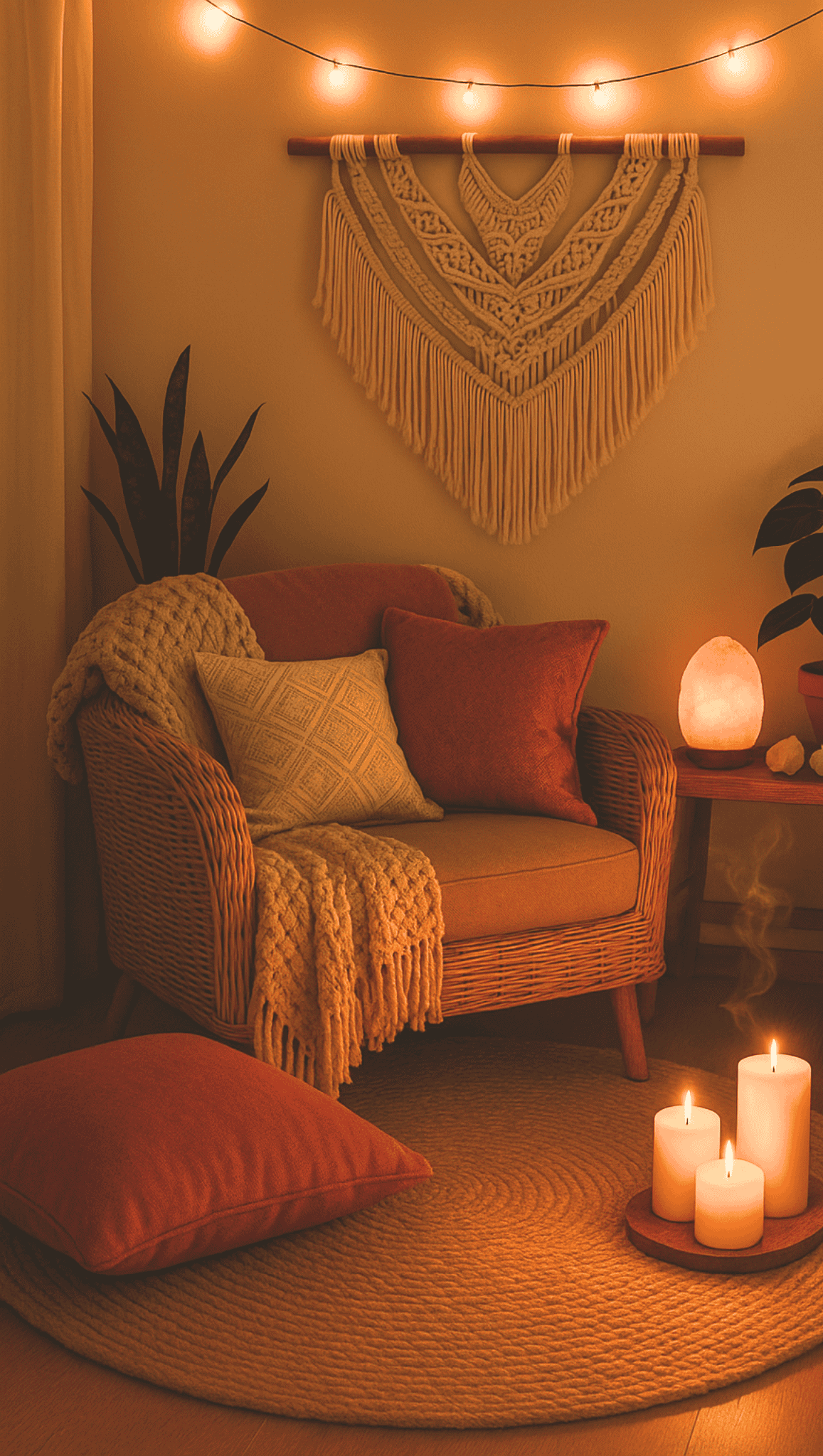
Lighting transforms your meditation practice more than any other element! When I replaced harsh overheads with salt lamps and string lights, my experience shifted to sacred tranquility. Lighting creates instant atmosphere – in bohemian design, aim for soft, layered, golden illumination that calms the mind. Even in the smallest budget nook, thoughtful lighting signals to your brain that this is a special place.
Natural light comes first – I rearranged my furniture to catch morning light when possible! But since we can’t always meditate during daylight, create options. Keep candles in fire-safe containers, warm-toned string lights (some battery-powered), and fabric-shaded lamps for beautiful diffused light. These options let you adjust based on mood and meditation intentions.
Benefits of Soft Lighting
Gentle, warm-toned lighting reduces stress hormones and helps signal to your body that it’s time to relax and turn inward for meditation.
Enhancing Mood with Light Layers
Using multiple light sources at different heights creates dimension in your space while allowing you to adjust the brightness for different practices.
Pairing Light with Shadow
The interplay of gentle light and soft shadows adds visual interest and depth to your meditation space, creating a dynamic yet peaceful environment.
How to Create Perfect Lighting
- Position your meditation space to take advantage of natural light when possible
- Use candles in fire-safe containers for a warm, flickering glow
- Hang string lights along walls or drape them through fabric canopies
- Try Himalayan salt lamps for their warm color and potential health benefits
- Place small LED tea lights in colored glass containers for safe ambient light
- Consider light-filtering options like sheer curtains to soften harsh daylight
7. Bringing Nature Indoors: Plants for Your Zen Space
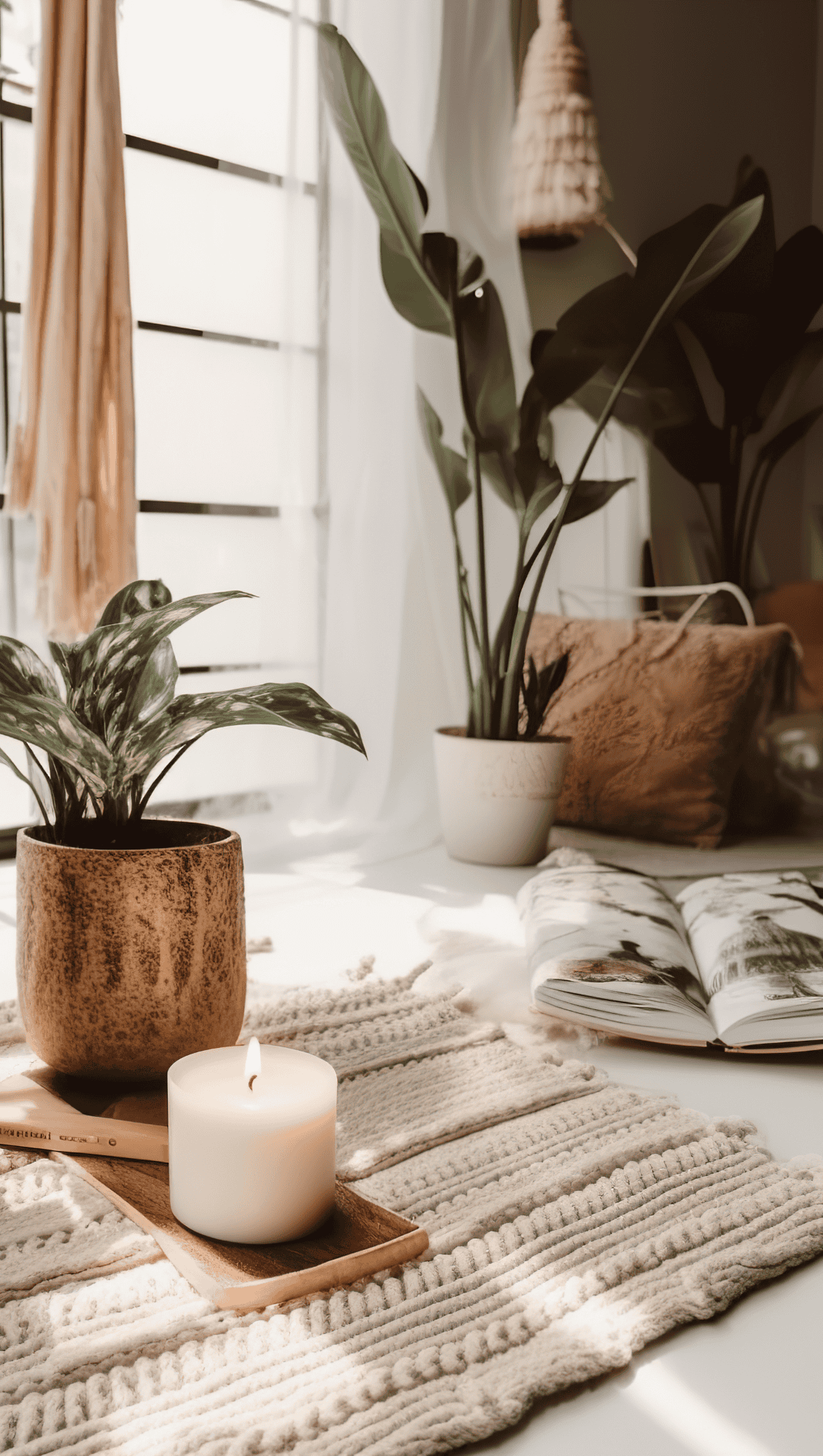
My meditation practice deepened when I surrounded my nook with plants! There’s something magical about living greenery that calms your nervous system and connects you to natural rhythms. Starting with just one or two easy-care varieties and gradually expanding creates both beauty and sustainability on a budget. Plants are essential to bohemian design – incorporate them through cuttings, propagation, and selecting resilient varieties.
The relationship between mindfulness and plant care has become a favorite part of my practice! Tending to plants creates moments of presence that reinforce intentions. For those worried about maintenance, start with indestructible pothos and snake plants. If limited natural light or travel schedules make live plants challenging, high-quality artificial options or dried botanicals provide similar aesthetic benefits.
Benefits of Indoor Plants
Plants naturally purify air while adding life energy to your meditation space, creating a microenvironment that supports deeper breathing and relaxation.
Enhancing Connection to Nature
Surrounding yourself with plants during meditation reinforces your connection to the natural world, an essential element of spiritual well-being in many traditions.
Pairing Plants with Purpose
Different plants carry different energies – some, like lavender or jasmine, add calming scents, while others, like ferns, add visual movement and texture.
How to Incorporate Plants Thoughtfully
- Start with 1-2 easy-care varieties like pothos, ZZ plants, or snake plants
- Propagate your own plants from cuttings to expand your collection for free
- Use varying heights and textures – trailing plants on shelves, floor plants in corners
- Repurpose containers you already own as planters – baskets, ceramic bowls, etc.
- Consider air plants which need minimal care and can be displayed in creative ways
- Include dried botanical elements like pampas grass, eucalyptus, or preserved ferns
8. Sound Elements for Your Bohemian Meditation Space

Adding sound elements transformed my practice from visual to fully sensory! A small wind chime near my meditation corner immediately shifted the energy and signaled my brain it was time to be present. Sound serves multiple purposes – masking distractions, creating frequencies for specific meditation goals, and adding another sensory layer. Natural and handcrafted sound elements perfectly complement bohemian aesthetics.
Creating a sound-rich environment doesn’t require expensive equipment! My favorite elements have been the simplest – thrift store bells, a homemade rain stick from a cardboard tube and beans, or bamboo chimes by a window. For guided meditations, an inexpensive bluetooth speaker hidden in a basket maintains the natural aesthetic. Having various options lets you adapt – sometimes silence is perfect, other times gentle sounds help maintain focus.
Benefits of Natural Sounds
Wind chimes, water fountains, and rain sticks produce sounds that naturally entrain the brain to more peaceful states while masking disruptive household noises.
Enhancing Meditation Through Frequency
Different sound tools like singing bowls or bells create specific frequencies that can help you achieve particular meditation states more effectively.
Pairing Sound with Silence
The contrast between intentional sound elements and moments of silence creates a dynamic meditation experience that helps maintain focus and presence.
How to Add Sound Elements
- Hang small wind chimes where gentle air movement will activate them
- Create a simple water feature using a small pump and bowl you already own
- Place a collection of bells or singing bowls within reach for beginning or ending practice
- Make your own rain stick from a cardboard tube filled with rice or beans
- Use a small, disguised bluetooth speaker for meditation music or nature sounds
- Place sound-absorbing elements like tapestries and cushions to improve acoustics
9. Scent and Sensory Elements to Enhance Your Practice
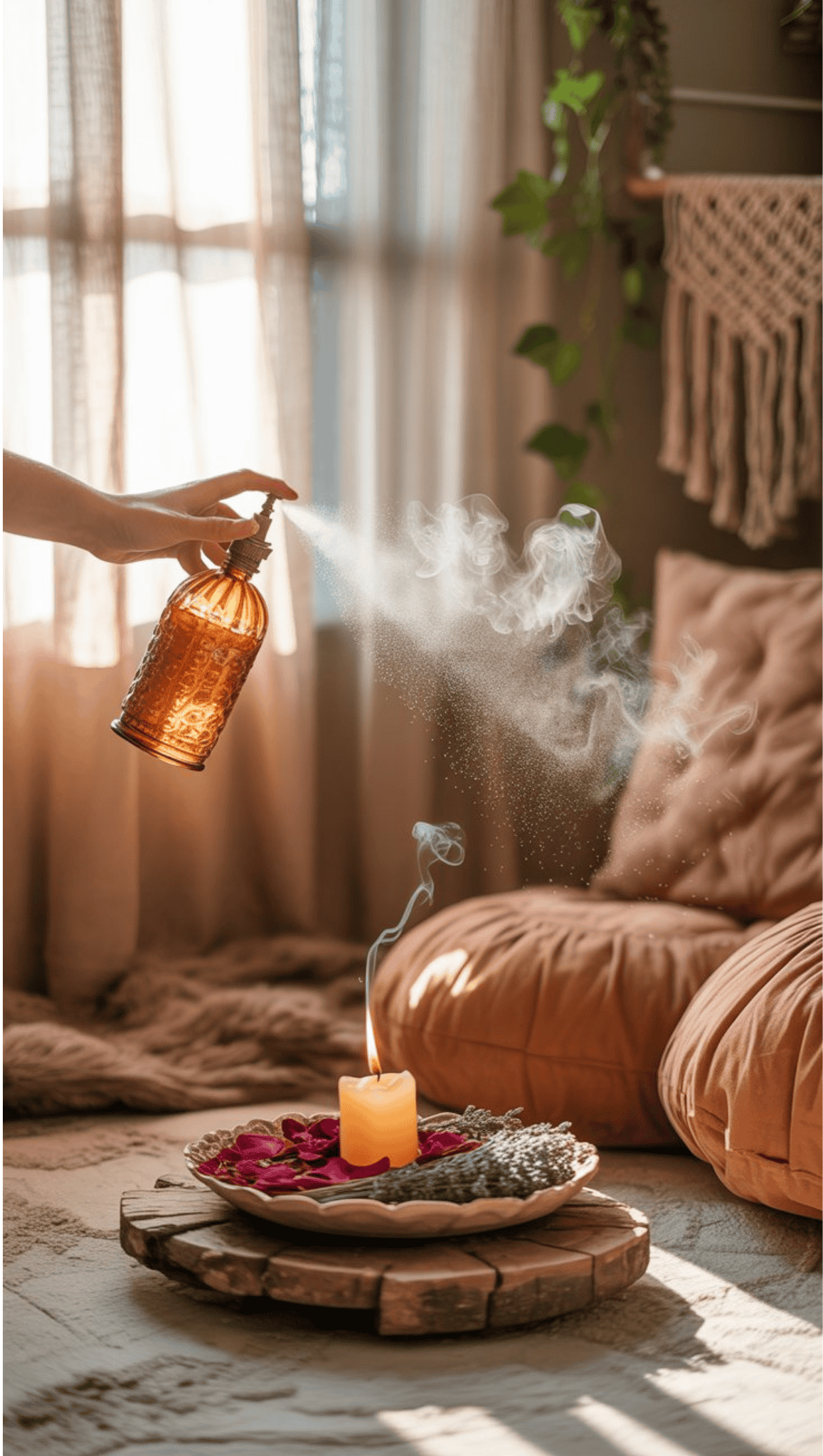
Adding intentional scents to your meditation space will deepen your practice dramatically! Our sense of smell bypasses our logical brain and speaks directly to emotions, creating a sanctuary that shifts your state immediately. You don’t need expensive diffusers or fancy incense – there are countless budget-friendly alternatives that perfectly complement bohemian aesthetics.
Create a signature scent for your space as a ritual signaling it’s time for mindfulness! Identify scents that help you feel alert yet calm – citrus and sandalwood work for me. Try simple methods like placing essential oil drops on wooden beads, making room sprays with oils diluted in water, or using natural elements like dried herbs, lavender, rose petals and citrus peels that double as beautiful decorations.
Benefits of Natural Scents
Plant-based aromas like essential oils, herbs, and resins can have therapeutic properties that support different types of meditation practices and intentions.
Enhancing Neural Pathways
Using the same scent consistently during meditation creates a powerful neural association that helps you drop into a meditative state more quickly over time.
Pairing Aromatherapy with Intention
Different scents support different meditation goals – lavender for relaxation, rosemary for focus, citrus for energy, and sandalwood for grounding.
How to Create a Scented Sanctuary
- Make your own room spray with 10 drops of essential oil in 2oz of water
- Create scent sachets with dried herbs like lavender, rosemary, or sage
- Place a few drops of oil on wooden beads or unfinished wood elements
- Make simmer pots with water and natural elements like citrus peels and cinnamon
- Use beeswax candles which naturally purify air while adding subtle honey scent
- Grow small pots of aromatic herbs like mint or basil near your meditation space
10. Storage Solutions That Maintain the Boho Aesthetic
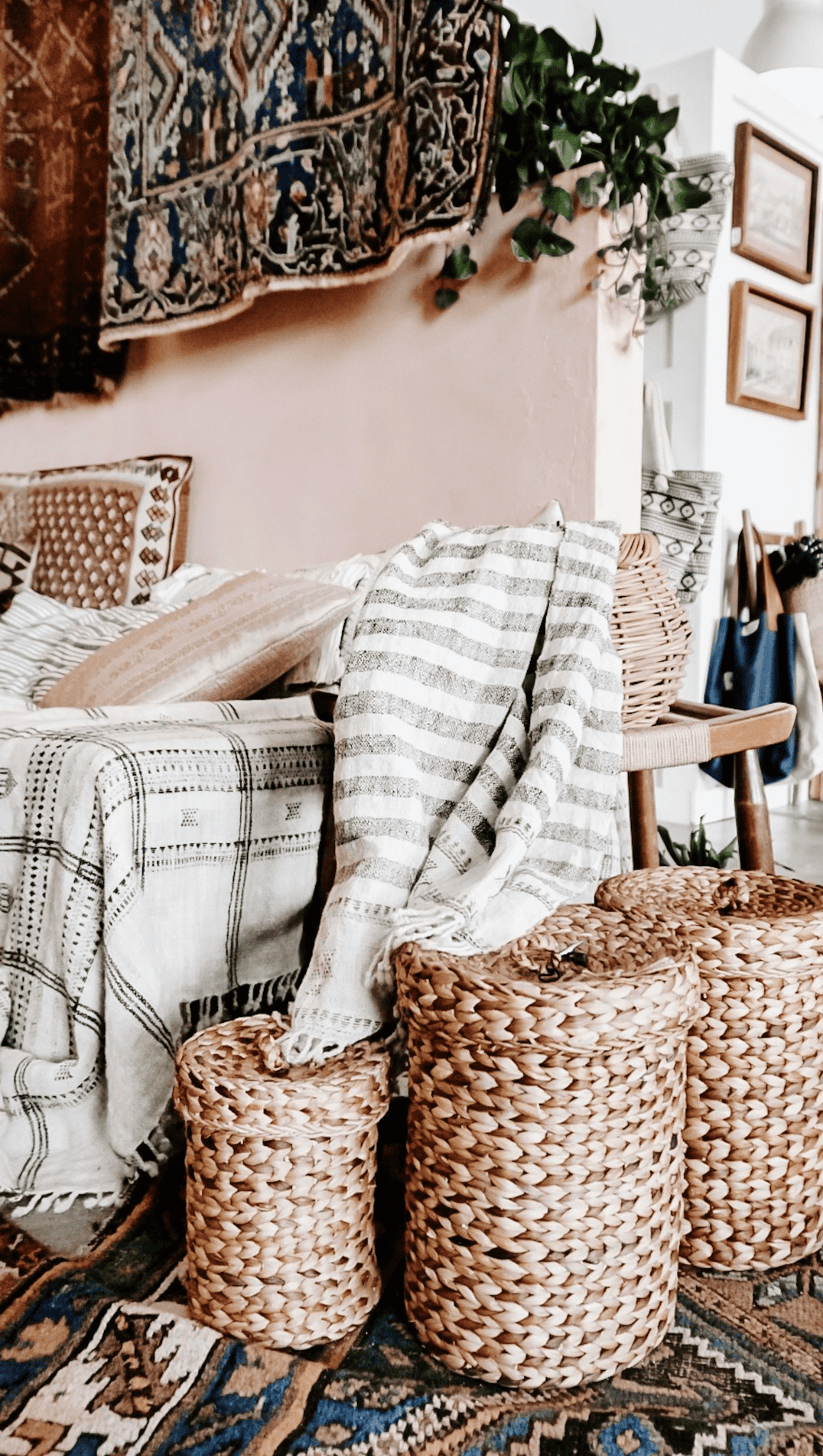
As my meditation practice grew, so did my collection of tools and sacred objects! Good storage keeps things organized while honoring bohemian aesthetics. Unlike minimalist styles that hide everything, boho spaces celebrate your spiritual tools as part of the design. The challenge is balancing accessible display with avoiding clutter. Well-chosen storage pieces solve practical problems while becoming beautiful focal points.
Natural materials make storage align perfectly with boho meditation spaces! Wicker baskets, wooden boxes, fabric pouches, and ceramic vessels add texture while organizing your items. I started with what I had – a wine crate became a book shelf, fabric gift bags stored mala beads and oracle cards, large baskets kept cushions accessible while adding sculptural elements. The goal is abundant curation rather than hiding things away – your tools are part of the beauty, not distractions!
Benefits of Visible Storage
Using beautiful containers that display your meditation tools turns necessary storage into intentional decor that enhances your space.
Enhancing Organization Through Zoning
Grouping similar items together in designated areas helps maintain order while creating visual vignettes that contribute to the overall aesthetic.
Pairing Function with Beauty
The most successful storage solutions in boho spaces serve multiple purposes – a stack of books becomes a plant stand, a beautiful box holds tools while serving as an altar.
How to Create Organized Bohemian Storage
- Use baskets in varying sizes for larger items like cushions, blankets, and yoga props
- Repurpose wooden boxes, cigar boxes, or gift boxes for smaller objects
- Create wall storage with floating shelves made from reclaimed wood
- Utilize fabric pouches or small cloth bags for crystals and oracle cards
- Install hooks on walls or the backs of doors for hanging items like malas
- Look for multi-functional furniture like storage ottomans or benches with hidden compartments
11. Small Space Solutions: Creating a Meditation Nook in Tiny Areas
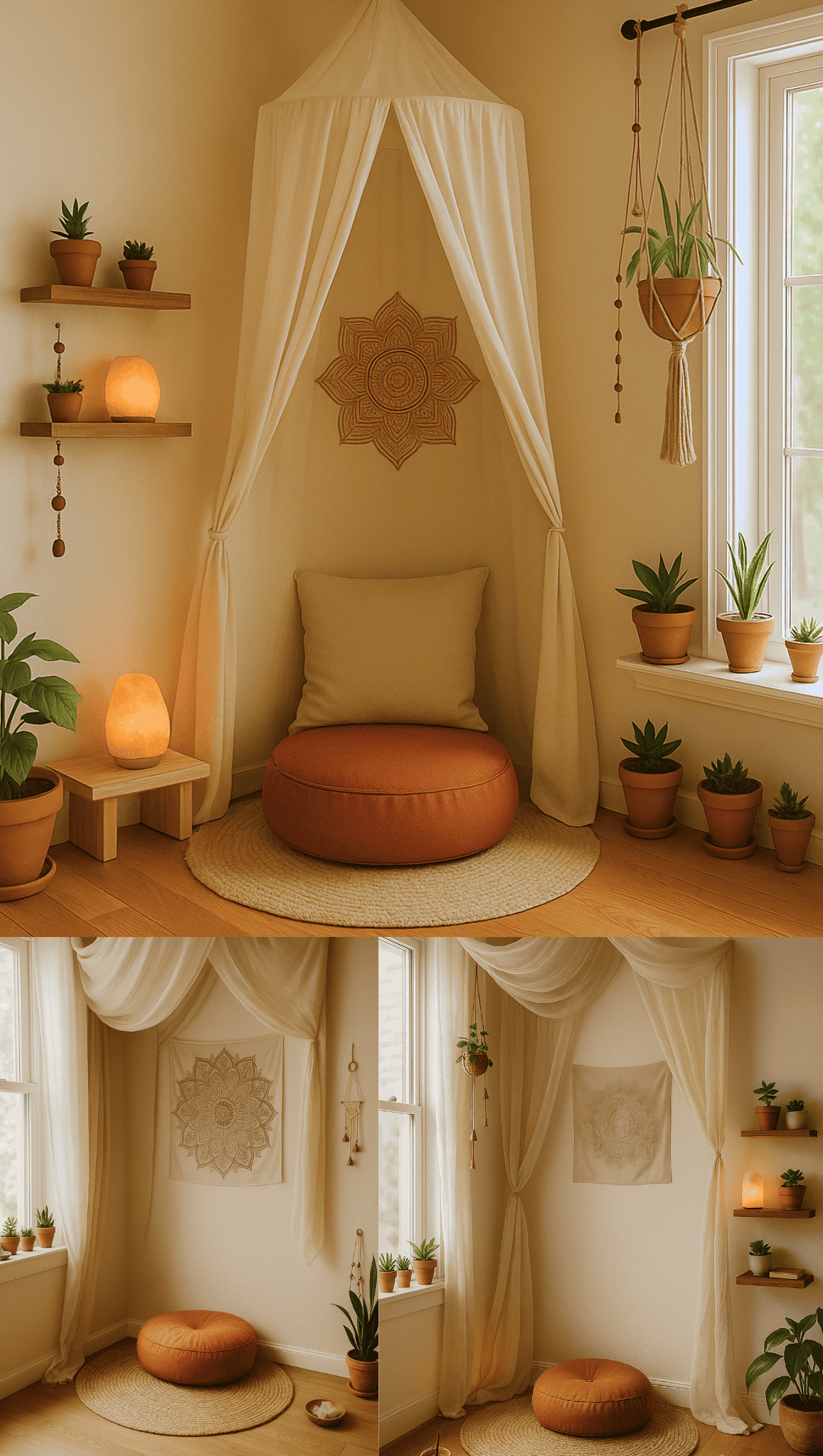
My first meditation space was a tiny 2×3 foot corner in my studio apartment! This taught me that spiritual practice doesn’t need square footage – just creativity and intention. In small spaces, each element should serve multiple purposes while maintaining a bohemian vibes. Think vertically – use walls, windows, and ceilings to expand the feeling without requiring floor area. My most profound meditation experiences happened in these tiny, thoughtfully designed nooks.
The secret to small-space meditation areas is creating psychological boundaries that define the space as special! Try simple techniques like a different flooring material (a small rug), a visual focal point at eye level, and distinct lighting. In one apartment, I transformed a window seat with cushions and plants creating a natural frame. Another time, I converted half a closet by removing the door and adding battery lights and wall hangings.
Benefits of Vertical Design
Using wall space for hanging elements, shelving, and vertical storage maximizes your limited floor area while creating visual interest above your meditation seat.
Enhancing Perception Through Psychology
Creating clear visual and sensory boundaries helps your brain recognize even the smallest space as a distinct zone dedicated to your practice.
Pairing Multifunction with Intention
In small spaces, elements often need to serve multiple purposes – a meditation cushion might become floor seating for guests, but specific rituals help maintain its sacred purpose.
How to Maximize Tiny Meditation Areas
- Use corner spaces which often go underutilized in small homes
- Create a window meditation seat with cushions and privacy elements
- Transform part of a closet by removing or opening the door
- Use a folding screen or hanging fabric to section off a meditation zone
- Invest in foldable or stackable meditation furniture that can be stored when not in use
- Create a “meditation box” that contains all elements and can transform any small space temporarily
12. Outdoor Boho Meditation Spaces: Patios, Balconies and Gardens
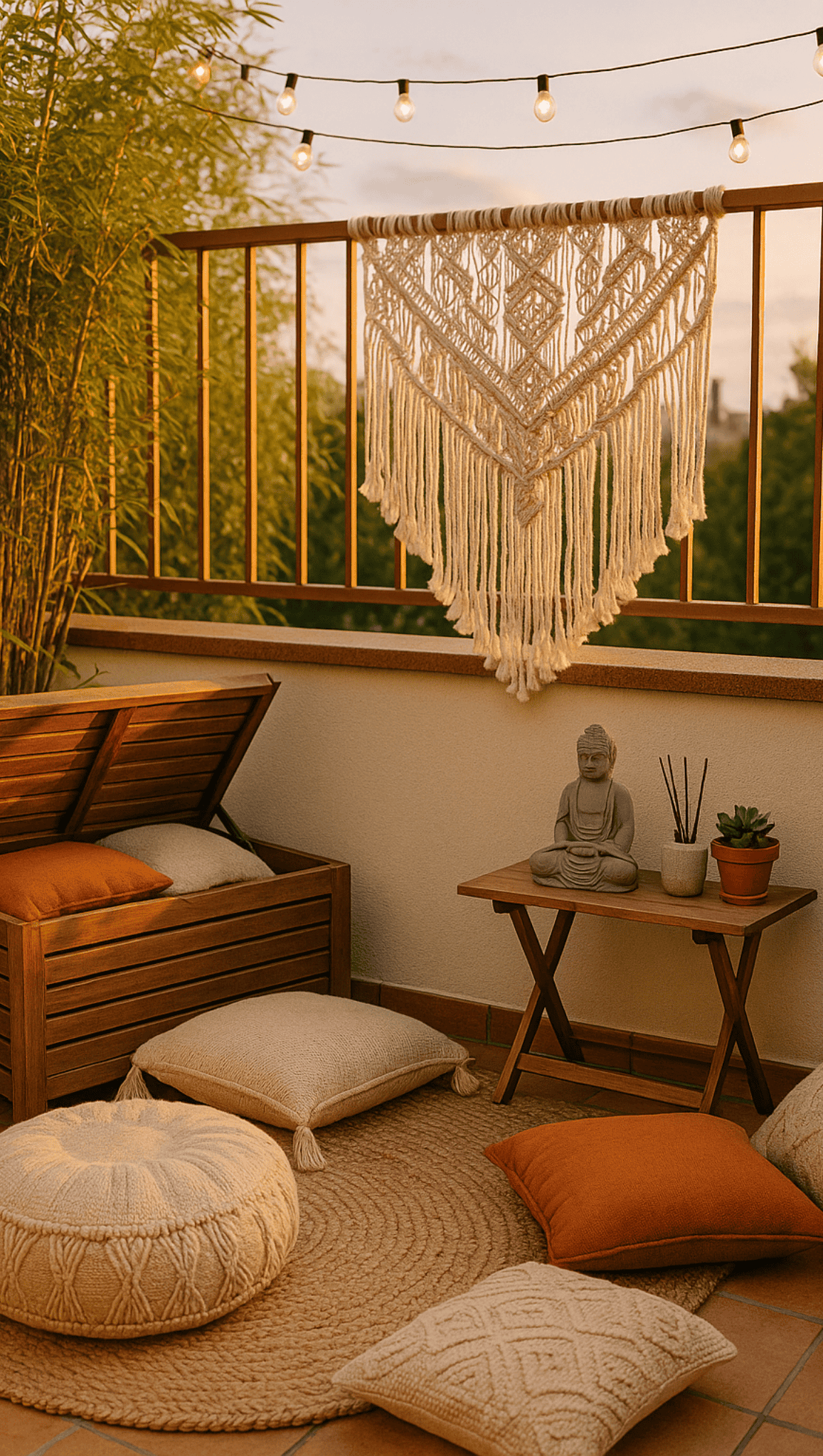
Connecting meditation to nature can revolutionized any practice! My tiny balcony became an outdoor sanctuary combining bohemian aesthetics with fresh air and natural surroundings. Outdoor spaces present unique challenges – weather, privacy, durability – but the rewards of practicing with natural elements make it worthwhile durning the times of year when it’s possible. Even the smallest outdoor area transforms with thoughtful planning and weather-friendly solutions.
Creating a year-round outdoor meditation space requires creativity! Determine which elements need weather-resistance and which can be stored between uses. Weather-treated wooden crates with outdoor cushions make meditation seats that withstand occasional rain. Choose quick-drying fabrics stored in weather-resistant containers. Add privacy with potted plants, bamboo screens, and strategically hung outdoor fabric. Birds singing and breezes flowing add elements no indoor space can provide!
Benefits of Outdoor Practice
Meditating in fresh air provides extra oxygen to your brain while the sounds and sensations of nature naturally support mindfulness and present-moment awareness.
Enhancing Weather Adaptability
Creating solutions for different weather conditions allows you to maintain your practice regardless of temperature or precipitation, expanding your connection to seasonal changes.
Pairing Comfort with Durability
The most successful outdoor meditation spaces balance comfort features like cushions and textiles with weather-resistant elements that can withstand exposure.
How to Create an Outdoor Sanctuary
- Use weather-resistant flooring like outdoor rugs, deck tiles, or treated wooden platforms
- Invest in storage that protects cushions and fabrics when not in use
- Create shade with umbrellas, fabric canopies, or strategically placed plants
- Add privacy with bamboo screens, outdoor curtains, or trellises with climbing plants
- Include lighting for evening meditation – solar options eliminate the need for outlets
- Consider a small table or shelf that can be covered to protect meditation tools
13. Seasonal Refreshes for Your Boho Meditation Space

Changing up your meditation space with the seasons can add new depth and renewal to your practice! Seasonal refreshes don’t require major investments – just swapping a few elements creates an entirely new experience. Keep a core foundation of neutral pieces with seasonal accents for easy transformation. Something as simple as changing pillow covers from earthy autumn tones to bright spring hues shifts the entire energy of your space.
Seasonal adjustments serve practical purposes too! During cold months, add warm textiles – chunky knit blankets, sheepskin rugs, and velvet pillows make floor sitting cozy. Summer brings lightweight cotton and linen that feel cool and allow better airflow. Rotate plants based on seasonal thriving and adjust lighting for shorter or longer days. Change scents seasonally too – warming cinnamon in winter giving way to bright citrus in spring keeps your practice environment aligned with nature.
Benefits of Seasonal Changes
Refreshing your meditation space with the seasons creates novelty that can reinvigorate a stagnant practice while deepening your connection to natural cycles.
Enhancing Sensory Awareness
Seasonal adjustments to textures, scents, and colors heighten your sensory experience during meditation and prevent habituation that can lead to mindless routine.
Pairing Practicality with Symbolism
The most meaningful seasonal changes address practical needs like temperature while also honoring the symbolic qualities of each season – renewal, abundance, introspection, and rest.
How to Refresh Your Space Seasonally
- Create a collection of pillow covers in different seasonal colors that can be swapped easily
- Adjust textiles based on temperature – lighter fabrics for warm seasons, heavier for cool
- Change botanical elements with the seasons – dried arrangements in winter, fresh flowers in spring
- Rotate artwork or altar objects to reflect seasonal themes and energies
- Adjust lighting based on seasonal daylight changes
- Update scents to complement the energy of each season
14. Finding Your Meditation Style: Personalizing Your Boho Space
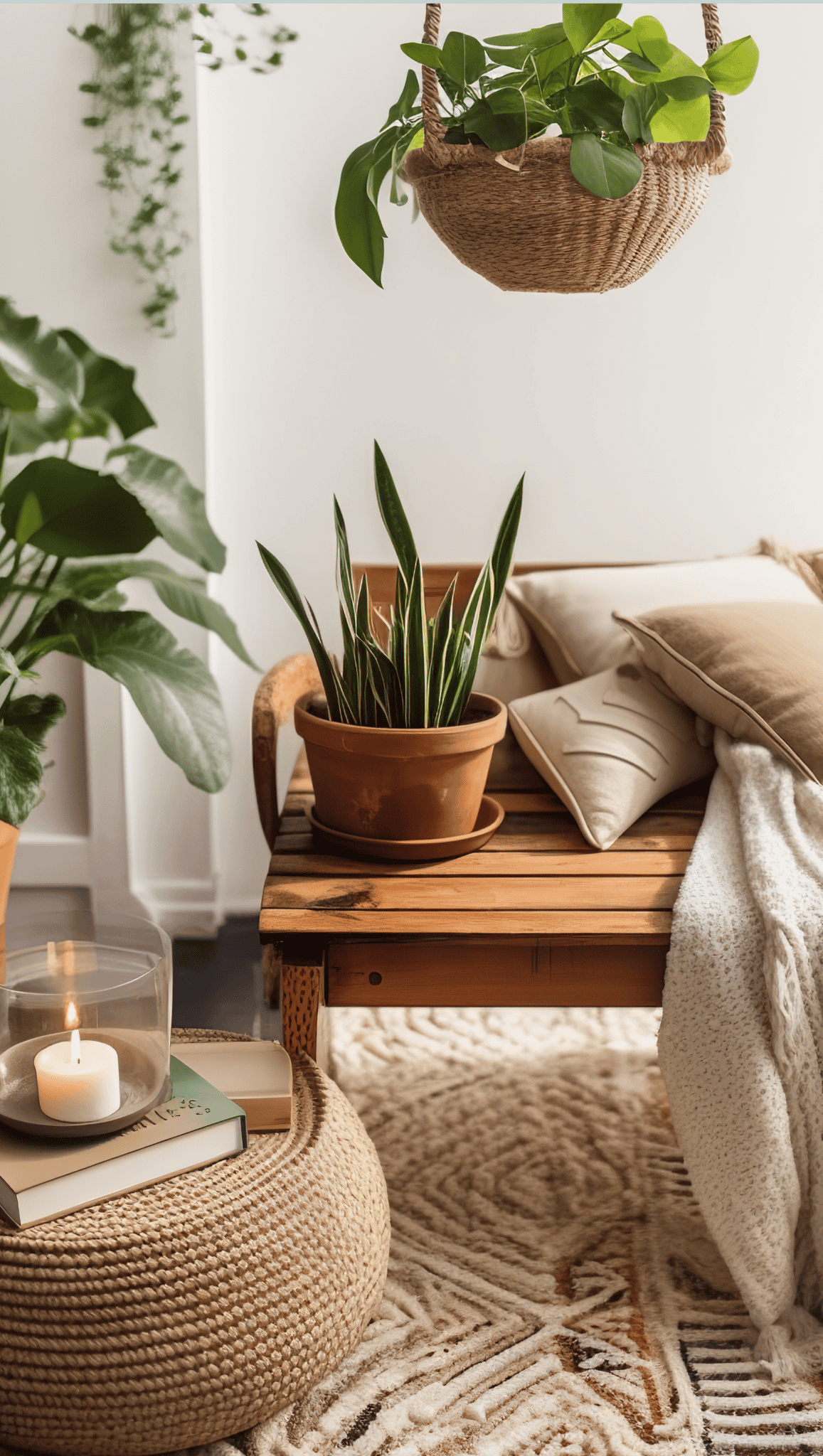
Creating a meditation space that supports your unique practice style makes all the difference! I found my practice deepened when I designed my space around how I naturally connect with mindfulness. Some people thrive with movement and sound, others need complete stillness, while some meditate through creativity or study. Your boho space should reflect your authentic approach rather than someone else’s idea of “proper” meditation.
Bohemian design celebrates personal expression and comfort above rules! Notice how you naturally practice – Do you fidget? Try a meditation stool that allows movement. Love spiritual reading? Create a cozy corner with good lighting and a small bookshelf. Enjoy sound healing? Make room for instruments. My space includes both a chair and an area for gentle stretching because I need movement before stillness. The most effective meditation space grows from your actual practice rather than an idealized vision.
Benefits of Style-Aligned Spaces
A meditation space designed around your natural tendencies removes friction, making consistent practice easier and more enjoyable.
Enhancing Personal Connection
Elements that resonate with your unique approach create a deeper sense of ownership, increasing your desire to return to your practice regularly.
Pairing Functionality with Intuition
The most effective personalized spaces balance practical support for your specific meditation style with elements that simply feel right for your practice.
How to Personalize Your Space
- Observe your natural tendencies – movement, stillness, sound, silence
- Adjust seating to support your body’s preferred meditation posture
- Include tools specific to your practice (journals, cards, singing bowls)
- Create different zones if you practice various meditation types
- Allow your space to evolve as your practice deepens
- Trust your intuition rather than following trends
15. Maintaining Your Sacred Space: Cleaning and Care Tips
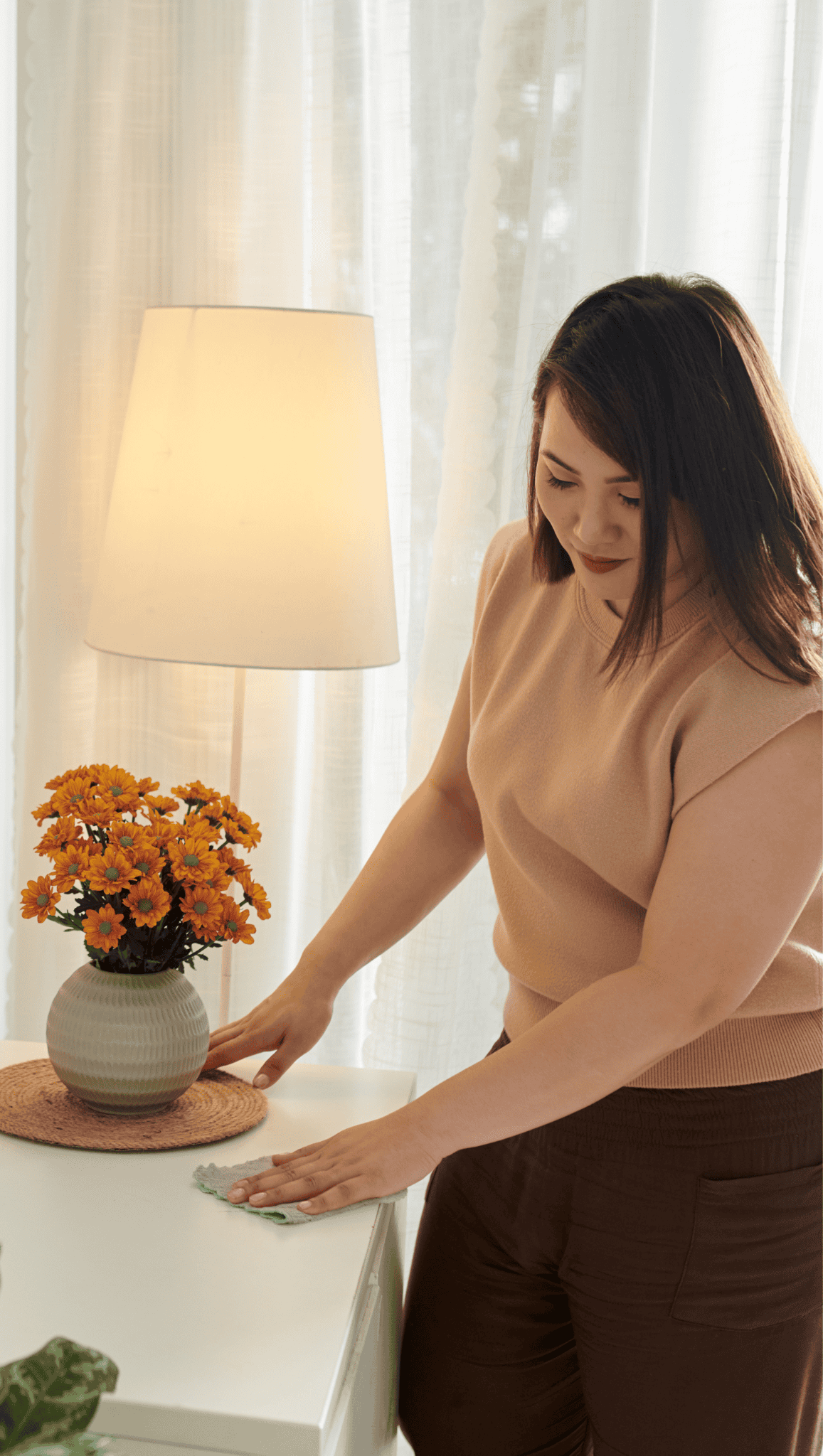
Regular cleansing of my meditation space immediately improved my sessions! Beyond physical tidiness, sacred spaces need energetic refreshing that clears stagnation. When first creating my nook, I focused only on setup and neglected maintenance. Soon I noticed dust on altar objects, cushions losing shape, and fabrics absorbing odors subtly detracted from the sanctuary feeling. Simple routines for both physical and energetic clearing have become extensions of my mindfulness practice.
For textiles like cushion covers and tapestries, schedule regular washing following care instructions. Wood elements need occasional conditioning with natural oils to prevent drying. Plants require attention to dust removal and health checks. Beyond physical cleaning, incorporate energetic cleansing with sound (ringing bells), smoke (herbs like sage), or visualization techniques. These practices become meaningful rituals deepening your connection rather than feeling like chores.
Benefits of Regular Maintenance
Consistent cleaning and clearing prevents energy stagnation while preserving the beauty and functionality of your meditation elements.
Enhancing Energetic Clarity
Regular energetic cleansing helps maintain the distinct vibrational quality of your meditation space, separate from the everyday energy of your home.
Pairing Physical Care with Intention
The most effective maintenance routines address both material care needs and energetic refreshment, treating both as sacred aspects of your practice.
How to Create Care Routines
- Establish a weekly quick-clean routine for dusting surfaces and tidying elements
- Schedule monthly deeper cleaning of textiles and floors
- Develop seasonal rituals for refreshing the energy and deepening your connection
- Use natural cleaning products without harsh chemicals that might disrupt the space’s energy
- Clear energy regularly using sound, smoke, or visualization techniques
- Create opening and closing rituals that maintain energetic boundaries when you’re not using the space
Final Thoughts

Creating a boho-inspired meditation space on a budget isn’t just about following design trends—it’s about crafting a personal sanctuary that nurtures your spiritual practice while honoring your financial reality. Throughout this journey of exploring fifteen different aspects of budget-friendly meditation spaces, we’ve seen that authentic sacred spaces emerge from intention rather than expense.
The most beautiful and effective meditation environments reflect your unique spirit while supporting your practice needs, whether you’re transforming a tiny apartment corner or designing an elaborate outdoor sanctuary. Remember that your space will evolve as your practice deepens, so begin with elements that speak to your heart and allow the space to grow organically over time.
What makes bohemian meditation spaces so perfectly suited to budget constraints is their embrace of imperfection, handcrafted elements, and meaningful curation rather than matching sets or designer pieces! Start by defining your space with comfortable seating and simple textiles, then gradually add elements that engage all your senses—plants for visual beauty and air purification, sound tools for auditory focus, natural scents for olfactory grounding, and varied textures for tactile awareness.
Don’t be afraid to repurpose items you already own, shop secondhand, or create your own meditation tools. The story behind each element adds richness to your practice that no expensive store-bought item can provide. Your journey toward creating a budget boho meditation space is itself a mindfulness practice—one of intention, creativity, and deep appreciation for bringing beauty into your daily life.
This post may contain affiliate links. I only recommend products and services I genuinely believe in. Additionally, some images on this website may have been created with the help of AI to convey the feeling or ideas I wish to share with the reader.
Frequently Asked Questions
How much space do I really need for a meditation area?
You need far less space than you might imagine for an effective meditation area. Even a 2×3 foot corner can become a dedicated practice space when defined with intention. The key is creating clear boundaries between your meditation area and the rest of your living space, which can be accomplished with rugs, lighting changes, or fabric dividers. Many practitioners find that small, clearly defined spaces actually support deeper focus than larger areas that might encourage distraction. If your space is extremely limited, consider creating a portable meditation kit that can transform any available area into a temporary sanctuary.
What if I live with roommates or family who don’t share my interest in meditation?
Shared living situations require thoughtful negotiation of space, but don’t make meditation areas impossible! Consider creating a space that serves multiple functions—a reading nook that transforms into a meditation corner, or a pleasant seating area that supports your practice when needed. Communicate with housemates about when you’ll be using the space for meditation and how important uninterrupted time is for your practice. Another solution is creating a meditation space within your bedroom or even adapting part of a closet, giving you privacy and control over the environment. Remember that respect goes both ways—ensure your practice and its accoutrements don’t impose on shared living areas.
How do I prevent my meditation space from collecting clutter?
Clutter is the natural enemy of the peace we seek in meditation spaces, yet bohemian aesthetics embrace abundance that can sometimes tip into disorganization if not mindfully managed. The key is creating systems that honor both the visual richness of boho style and the need for energetic clarity. Designate specific homes for all your meditation tools and accessories, using beautiful containers that contribute to the aesthetic rather than utilitarian storage. Develop the habit of returning items to their places immediately after use. Schedule regular decluttering sessions where you evaluate whether each element still serves your practice. Consider the energy of objects as well as their function—items that don’t resonate with your current practice can be gratefully released to make space for what’s most supportive now.
What’s the most important element to invest in if I’m on a very tight budget?
If your budget allows for only one quality investment, prioritize comfortable seating. Your meditation cushion, bench, or chair is the foundation of your physical practice, and discomfort can become a significant obstacle to consistency. While you can certainly begin with repurposed pillows or blankets, eventually investing in properly designed meditation seating will support your body properly and signal to your mind that your practice is worthy of resources. The good news is that once you have comfortable seating, nearly everything else in a boho meditation space can be created through thoughtful repurposing, thrifting, or DIY projects. Plants can be propagated from cuttings, textiles found secondhand, and lighting created from simple string lights or candles you already own.
How do I create a meditation space that grows with my practice?
The beauty of a bohemian-inspired meditation space is its natural adaptability to your evolving practice! Create a foundation of neutral elements that will remain relevant as your needs change—quality seating, simple altar surfaces, and basic textiles in natural colors. As your practice develops, you can add, remove, or replace elements that support specific aspects of your meditation journey. Keep your arrangement flexible rather than permanent, using free-standing elements rather than installed features when possible. Pay attention to how your practice changes over time and allow your space to reflect this evolution. Perhaps most importantly, maintain regular clearing practices—both physical and energetic—to prevent stagnation and create space for growth.
About The Author
Jahlila is a Transformational Whole Self and Wellness Lifestyle Empowerment Coach, a devoted mother, passionate writer, and a fervent advocate for holistic wellness. She is the creator of The Tri-Sync Method, a comprehensive coaching program designed to help women establish a personalized wellness and self-care lifestyle for enduring total health wellness.
Her journey has transitioned from focusing solely on health and fitness to embracing a broader mission: empowering women through holistic approaches that unite body, mind, and spirit. Jahlila is dedicated to teaching, coaching, writing, and speaking about how wellness intersects with a joyful, balanced life. Her mission is to motivate women to prioritize and achieve their wellness goals, fostering a deep connection between a vibrant lifestyle and true happiness. Ready to reclaim your vitality, achieve mental clarity, and embrace your wellness journey? Explore more at The Tri-Sync Method.Com
Don’t wait another day to start living your healthiest, happiest life. Schedule a Free Discovery Consultation with Jahlila today to explore how The Tri-Sync Method can transform your life. For additional questions or personalized guidance, please visit our Contact Page.

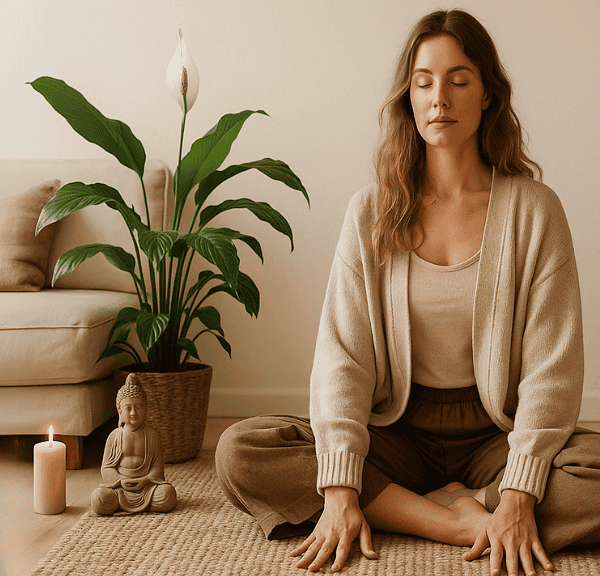
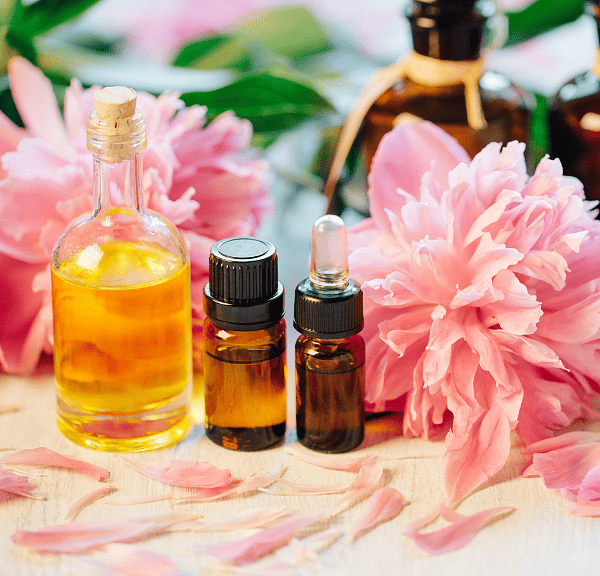
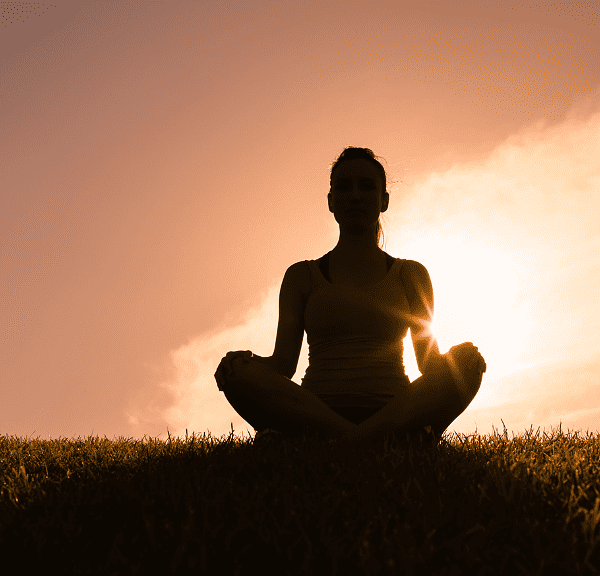
Leave a Reply